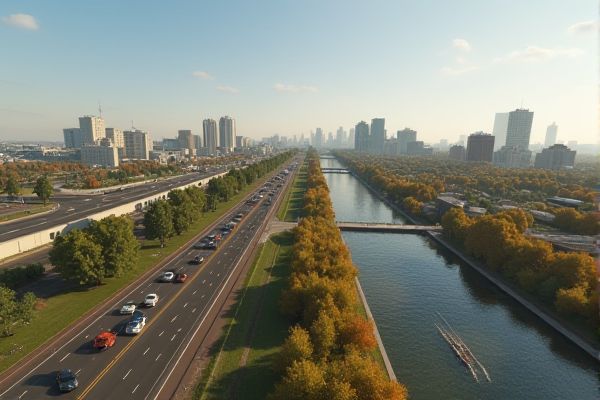
Internet and telecommunications options in North Dakota: Major providers include CenturyLink, Midco, HughesNet. Fiber-optic availability in urban areas. DSL and cable options in rural regions. 4G LTE and emerging 5G coverage. Satellite internet for remote locations. Average download speed: 50-100 Mbps. Affordable Connectivity Program support. Potential data caps on some plans. Telecommunications technologies: VOIP and landline. Check local provider reviews for reliability.
Major providers include CenturyLink, Midco, HughesNet.
In North Dakota, major internet providers include Midco, which offers widespread coverage with cable and fiber services up to 5,000 Mbps, and CenturyLink, which provides fiber and DSL services with maximum speeds of up to 940 Mbps. HughesNet is another option, particularly for rural areas, though it offers slower speeds of up to 25 Mbps.
Fiber-optic availability in urban areas.
Fiber-optic internet in North Dakota is more prevalent in rural areas than in urban areas. While providers like Midco and Quantum Fiber offer fiber plans, their fiber footprint is limited in urban areas, with better coverage and faster speeds often found in rural regions through local fiber ISPs. For more detailed information about the best internet providers in North Dakota, you can visit the website CNET.
DSL and cable options in rural regions.
In rural North Dakota, DSL options are primarily provided by CenturyLink, with speeds typically maxing out at 100Mbps but often being drastically slower depending on the location. Cable options are less common in rural areas, but Midco offers cable and fixed wireless internet in some regions, though its coverage is more limited compared to its urban areas. For more details on the best providers in the state, you can visit the CNET website for comprehensive insights.
4G LTE and emerging 5G coverage.
In North Dakota, Verizon is deploying 5G Ultra Wideband using up to 100 MHz of C-Band spectrum, enhancing mobile and home internet services with faster speeds and reliable connectivity. AT&T is also expanding its 5G network in the state, particularly in Eastern North Dakota, to improve wireless coverage and capacity for residents, businesses, and first responders.
Satellite internet for remote locations.
In North Dakota, satellite internet providers such as Starlink, Viasat, and HughesNet serve remote areas not covered by faster or more affordable options, offering necessary connectivity though often with lower speeds and higher costs compared to fiber or cable services. For further details on internet options, you can visit the Best Internet Providers in North Dakota page.
Average download speed: 50-100 Mbps.
In North Dakota, those seeking average download speeds between 50-100 Mbps have several options to consider. Midco offers plans starting at $39 a month for 50 Mbps, while CenturyLink DSL provides speeds up to 100 Mbps for $55 a month. Additionally, there are various local fiber internet service providers such as RTC and Red River Communications, though their availability can vary by location. For more comprehensive information on these options, you can visit the Best Internet Providers in North Dakota page on CNET. These choices offer North Dakotans a range of connectivity solutions to suit different needs and budgets.
Affordable Connectivity Program support.
The Affordable Connectivity Program (ACP) in North Dakota, managed by the FCC, provides significant financial assistance for individuals seeking improved internet access. Offering a monthly discount of up to $30 for broadband services, this program eases the financial burden for many families. Additionally, it provides a one-time discount of up to $100 for purchasing essential devices like a laptop, desktop, or tablet. Eligibility for these benefits is primarily determined based on household income or participation in specific government assistance programs. For more detailed information about this initiative, visit the Center for Rural Health Program which is committed to enhancing internet accessibility in North Dakota households.
Potential data caps on some plans.
In North Dakota, most internet providers, such as Midco, Red River Communications, and RTC, do not impose data caps on their plans. However, satellite internet providers like HughesNet and certain fixed wireless providers might have data caps, with HughesNet opting to throttle speeds rather than charge overage fees. For more information on the best internet providers in North Dakota, you can visit the CNET website.
Telecommunications technologies: VOIP and landline.
In North Dakota, telecommunications options include Voice over Internet Protocol (VoIP) and traditional landline services. The North Dakota Information Technology Department provides both analog and VoIP telephone services, with VoIP using the Internet or local data network to transmit voice signals, and landlines installed in remote areas where IP service is not available.
Check local provider reviews for reliability.
In North Dakota, Dickey Rural Networks is rated the highest for reliability and customer satisfaction, boasting a perfect 5.0 out of 5 rating, though it offers limited coverage. RTC Networks follows closely with a similar perfect rating for reliability and is regarded as the cheapest option based on customer reviews. For more detailed insights, you can explore comprehensive evaluations of these providers on the ISP Reports website.
